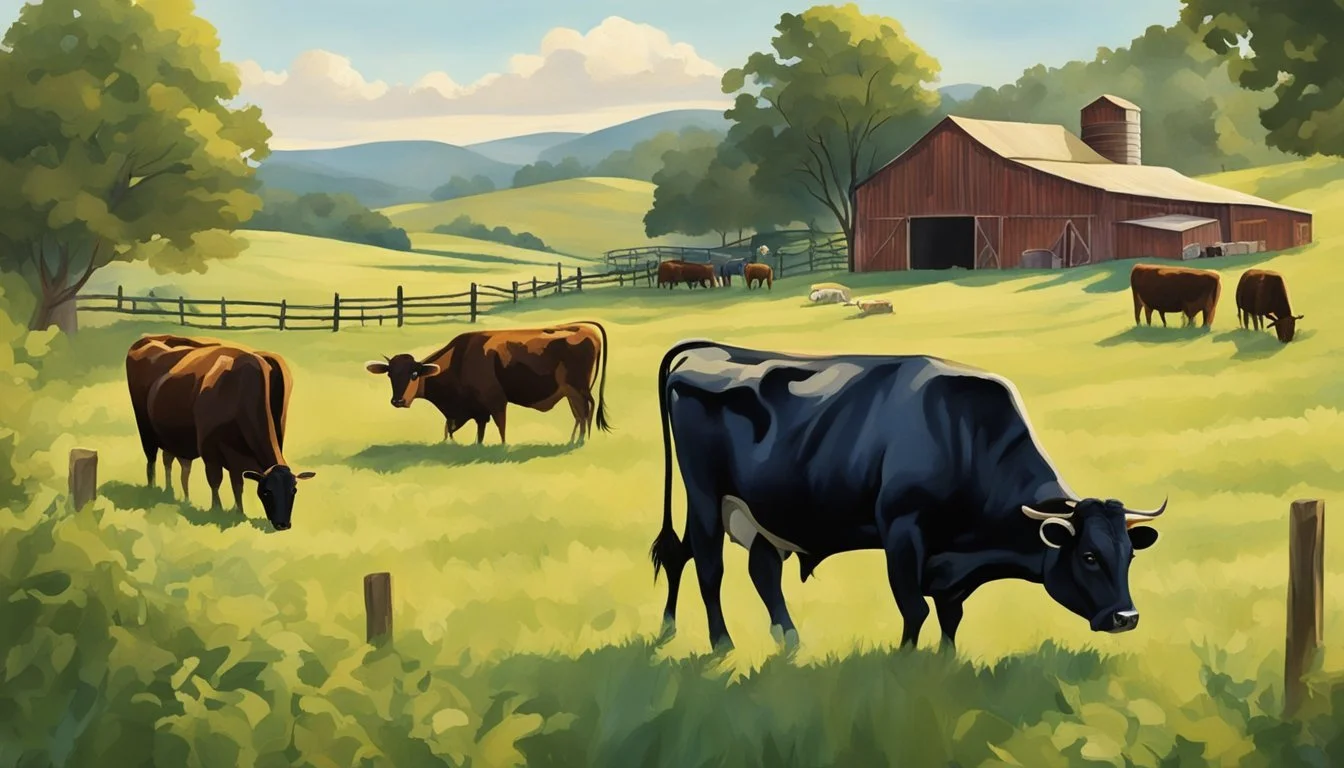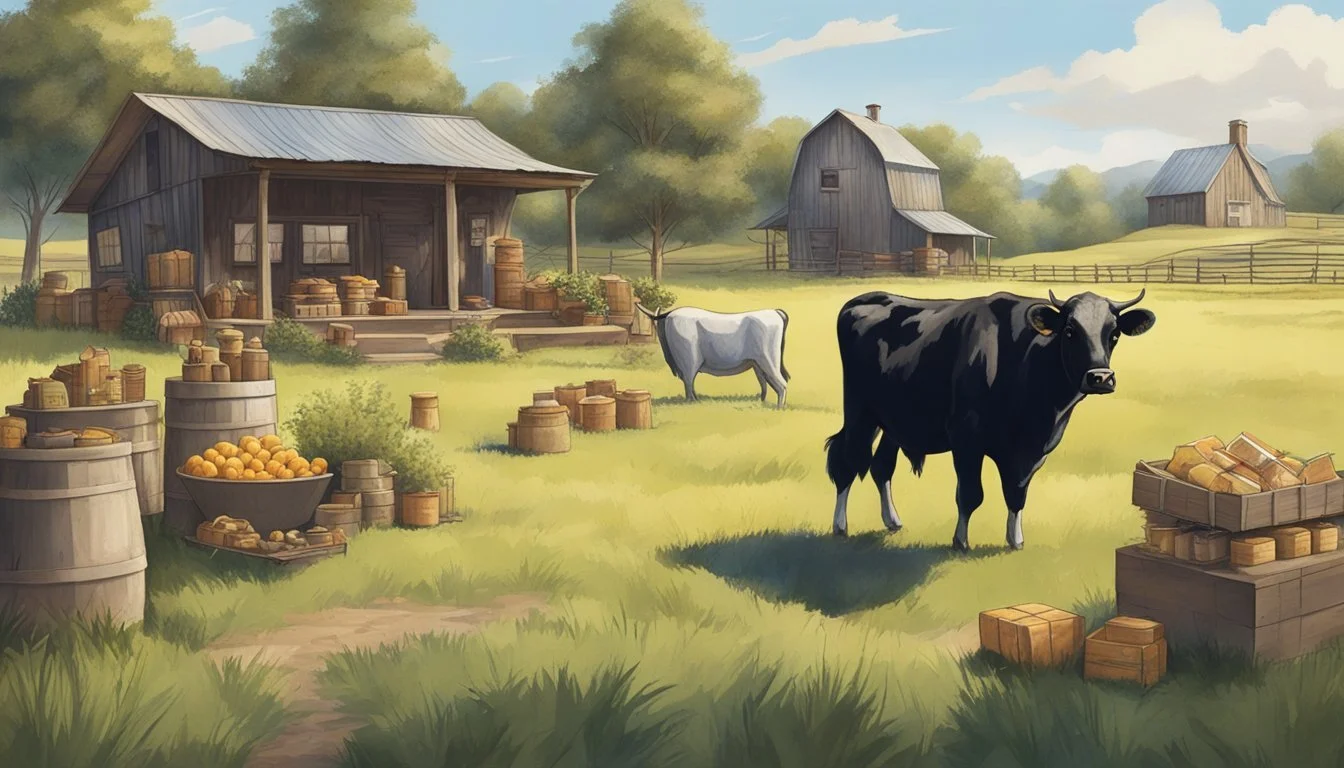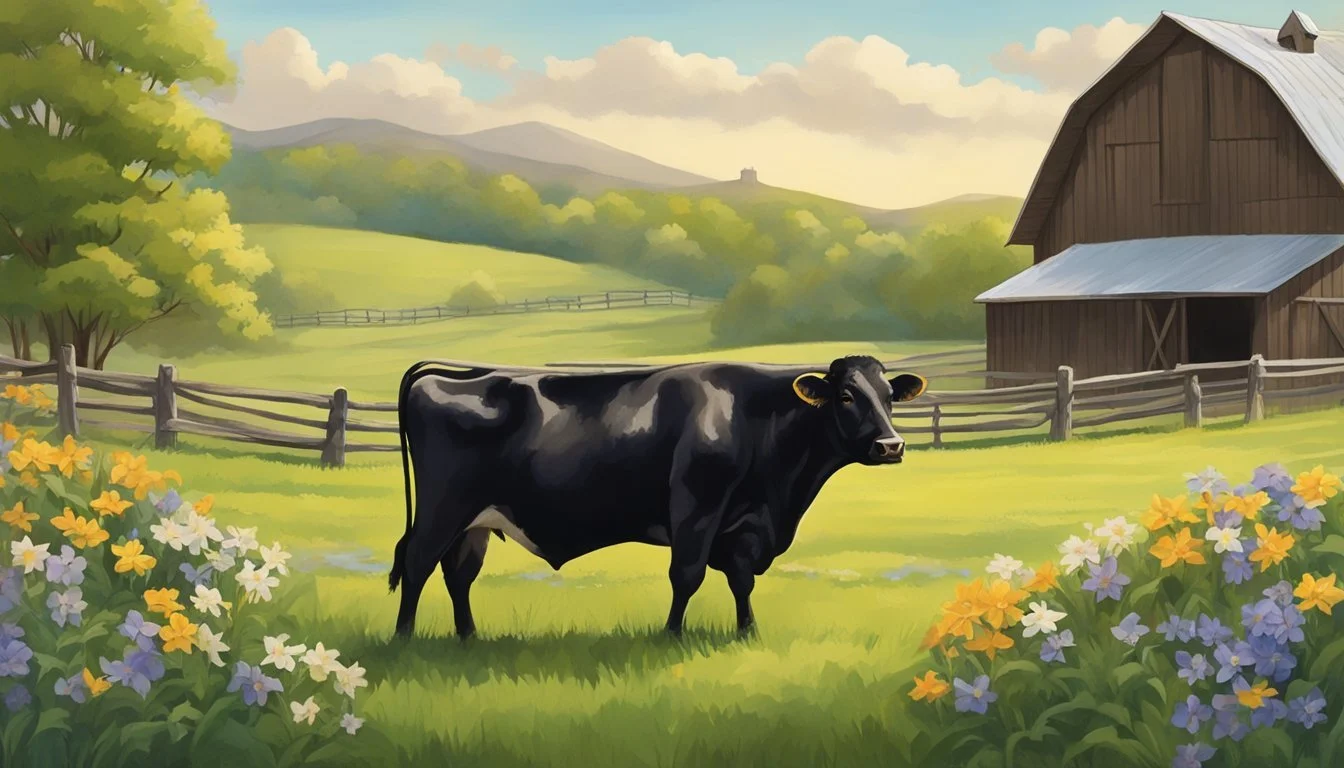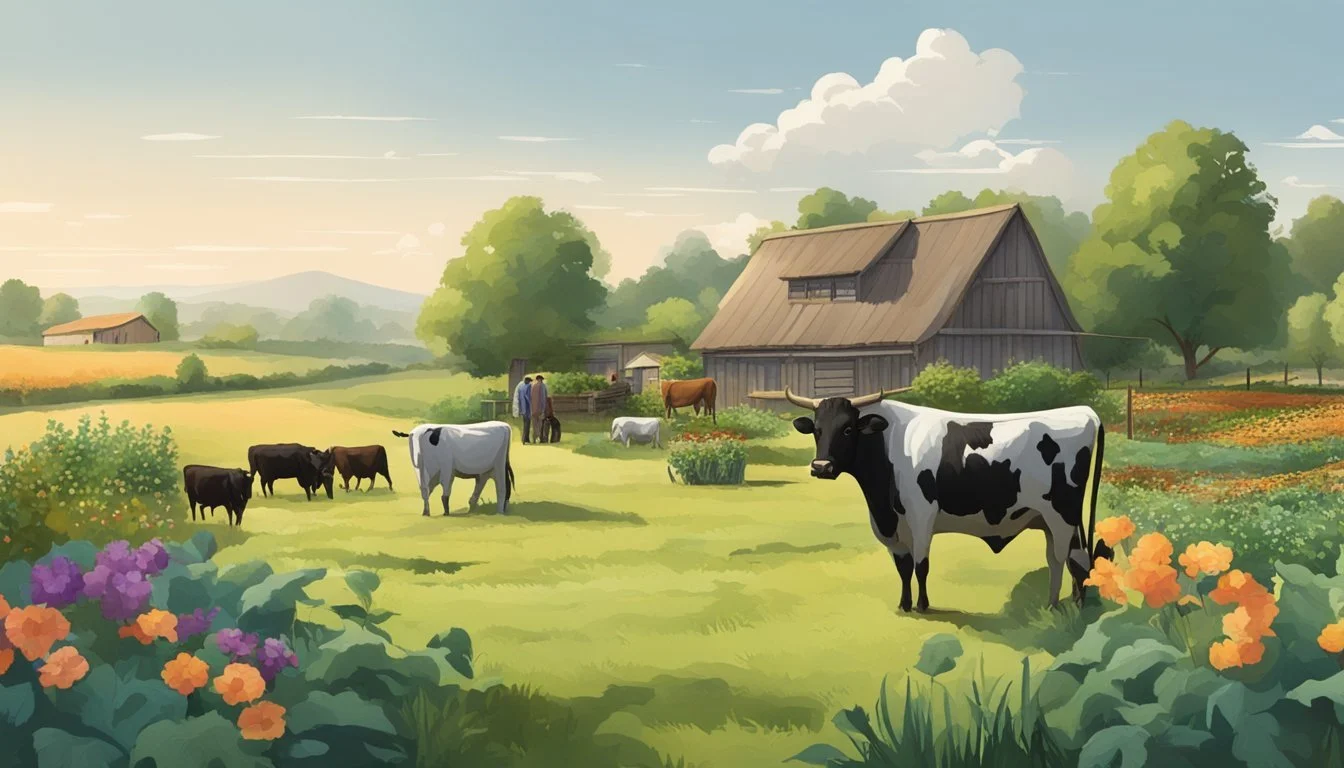Dexter Cattle and Artisanal Products
Diversifying Farm Revenue with Quality Goods
Dexter cattle serve as a valuable asset for homesteaders seeking to expand their offerings with artisanal products. Recognized for their modest size and dual-purpose capabilities, these cattle are an excellent livestock choice for small farms and homesteads. They consume less feed compared to larger breeds, which translates into cost savings and more manageable maintenance for owners. Dexter cattle provide high-quality beef with good meat to bone ratio, making them an economical choice for meat production. Additionally, their milk is known for being rich and flavorful, offering an opportunity for homesteaders to produce a variety of dairy products.
The trend towards local and sustainable farming practices has increased the demand for artisanal goods, and Dexter cattle are well-suited to meet this market niche. These small-breed cattle enable homesteaders to efficiently utilize limited land space while still producing an ample amount of product. With the ability to provide both meat and milk, Dexter cattle allow for diverse artisanal offerings such as specialty cheeses, yogurts, and premium cuts of beef. Their versatility and lower impact on resources make them ideal for homesteads venturing into niche markets and seeking to distinguish their product lineup.
For homesteaders, Dexter cattle represent more than just an addition to their livestock; they are a gateway to a sustainable livelihood. By incorporating these animals into their homesteading endeavors, farmers can enjoy the benefits of producing a variety of high-quality, artisanal products while also embracing an eco-friendly approach to agriculture. This integration aligns with the principles of homesteading, which emphasizes self-sufficiency and responsible land stewardship, cementing Dexter cattle as a cornerstone for expanding a homestead's offerings.
Understanding Dexter Cattle
Dexter Cattle are a versatile small breed, suitable for both beef and milk production, and are increasingly sought after for sustainable farming practices.
Breed Characteristics and Size
Dexter cattle originated in Ireland and are known for their smaller stature and robust build. They typically have well-rounded hindquarters and can have either short or long legs. The cows stand between 36 to 44 inches tall at the shoulder and weigh up to 750 pounds, making them considerably smaller than many other cattle breeds. This diminutive size often translates to easier handling and lower feed costs.
Color: The breed showcases three primary colors: black, which is most common, red, and dun (pale brown).
Horns: They can be horned or polled (naturally without horns), with the horned variety having short, moderately thick horns.
Disposition: Known for their docile temperament, Dexters are often considered ideal for small-scale farming.
Colors of Dexter Cattle
Color: Black
Frequency: Most common
Notes: Predominant color in the breed
Color: Dun
Frequency: Less common
Notes: Pale brown shade
Color: Red
Frequency: Least common
Notes: Can vary in shade
Health and Veterinary Care
When it comes to health, Dexter cattle are generally hardy animals but, like all breeds, they can be susceptible to certain conditions. Routine veterinary care is essential to maintain their health and productivity. Veterinary care includes regular check-ups, vaccinations, and prompt treatment of any illnesses.
Dexter cattle breeders must be vigilant about:
Breeding: Close attention should be paid to breeding practices to avoid inbreeding-related health issues due to the smaller genetic pool.
Diseases: Be on the lookout for common bovine diseases that can affect Dexter cattle, which require immediate veterinary attention.
Vaccinations: Keep up with a recommended vaccination schedule to prevent common infectious diseases.
The breed's small size and efficient feed conversion make Dexters an economical choice for homestead farming, with their hardy nature leading to generally lower veterinary costs compared to larger breeds. Their disposition and size also facilitate easier handling for health checks and veterinary procedures.
Incorporating Cattle into Your Homestead Layout
When integrating Dexter cattle into a homestead, one must thoughtfully plan the layout to account for their needs. This involves allocating enough land, providing suitable shelter, establishing secure fencing, and managing manure efficiently.
Planning for Adequate Land and Shelter
Land Allocation: Dexter cattle require less land than standard cattle breeds due to their size, but it's essential to provide enough space for grazing—a minimum of half an acre per cow is a solid starting point.
Shelter Needs: Construct shelters that are robust and weatherproof, ensuring they are spacious enough for the cattle to move comfortably and lie down. A typical shelter size for Dexter cattle is around 8x12 feet for up to three cows.
Fencing and Grazing Land Considerations
Fencing: Reliable fencing is vital for keeping cattle safe and contained. A perimeter fence should be at least 4 feet high and made of sturdy materials such as wooden posts and woven wire livestock fencing.
Electric Fencing: An additional strand of electric wire can prevent leaners and jumpers.
Grazing Rotation: Plan for a rotational grazing system to maintain land health. Divide the pasture into sections to allow for regrowth.
Manure Management and Composting
Manure Collection: Dexter cattle produce less manure than larger breeds—chart out regular collection points to facilitate cleanliness and health.
Composting Strategy: Compost the manure to create rich, organic matter to improve soil quality. A simple composting setup can include:
Layering manure with dry organic matter like straw or leaves.
Regularly turning the pile to aerate and accelerate decomposition.
Using the compost in the garden or selling as artisanal compost product.
Artisanal Products from Dexter Cattle
Dexter cattle offer a sustainable choice for small-scale farms looking to produce high-quality artisanal products such as milk, cheese, and grass-fed beef. They are a hardy Irish breed suited to producing a variety of dairy and meat products thanks to their efficient milk production and premium beef qualities.
Milking Protocols and Milk Production
Dexter cattle, renowned for their quality milk, require diligent milking protocols to ensure hygiene and maximize production. Their milk typically has a higher butterfat content, which contributes to the rich flavor and creaminess of the dairy products derived from it. It's crucial to maintain a consistent milking schedule, and proper teat sanitization to avoid contamination and ensure the welfare of the cows.
Milking Frequency: Twice daily
Hygiene Practices: Pre-milking udder disinfection, post-milking teat dipping
Average Milk Yield: 1.5 to 2.5 gallons per day
Butterfat Content: Approximately 4%
Beef Production and Sustainable Practices
Dexter cattle are not only productive dairy animals but also provide high-quality, lean beef. The beef from Dexter cattle is known for its exceptional taste and tenderness. With their smaller size, Dexters are easier to manage and require less feed compared to larger breeds, making them a sustainable option for eco-conscious farms.
Beef Quality: Lean and tender
Feed Efficiency: High forage conversion
Sustainable Advantage: Less land and feed required
Grass-Fed Assurance: Dexter cattle thrive on grass, aligning with sustainable farming practices
Creating Artisanal Cheese and Other Dairy Products
From the rich milk of Dexter cattle, farmers can craft a variety of artisanal cheeses, including mozzarella and other raw milk cheeses. These cheeses are valued for their distinct taste that reflects the grass-fed diet of the cattle. The higher protein and butterfat content in Dexter cow's milk lends a superior quality to the cheese produced, setting it apart from those made from conventional milk.
Cheese Variety: Mozzarella, Cheddar, Gouda
Key Milk Properties: High protein, superior butterfat
Artisanal Appeal: Unique flavors from a grass-based diet
Production Tips: Gentle pasteurization, use of traditional rennet, aging process matte
Seasonal Care and Breeding Cycles
To successfully rear Dexter cattle on a homestead, one must account for the nuances of seasonal changes which influence cattle needs and coordinate breeding cycles to be in harmony with these natural rhythms.
Understanding Seasonal Changes and Cattle Needs
Dexter cattle, a breed well-suited to diverse climates, demonstrate a robust nature, thriving across varying environmental conditions. During colder months, they require adequate shelter to prevent frostbite and access to unfrozen water. As seasons shift, one should adjust their dietary regimen, often increasing caloric intake in winter with quality hay and possibly grains, while ensuring a pasture-based diet in the summer for optimal health and self-sufficiency.
Temperature Fluctuations: A key concern is maintaining the cattle's comfort and health despite temperature changes. Providing shade in summer and windbreaks during winter are effective strategies.
Dietary Adjustments: The livestock’s nutritional needs alter with the seasons, and they may require supplemental feeding when foraging is less abundant.
Breeding Practices for Dexter Cattle
When it comes to breeding Dexter cattle, homesteaders often target specific seasons to align calving with favorable weather conditions, simplifying management and ensuring calf survival. Dexter cattle are generally bred once a year, with the gestation period lasting approximately 283 days. It is observed that bull calves may have slightly longer gestation periods than heifer calves.
Key Breeding Metrics:
Gestation period: Typically around 283 days for Dexter cattle.
Calving window: Expect delivery within 10 days on either side of the due date.
Breeding Cycle Optimization:
Time breeding to ensure calving occurs in milder climates to support calf survival and growth.
Monitor the herd for signs of estrus to establish accurate breeding dates, adjusting for a cycle that averages 21 days.
By closely monitoring and adapting to the seasonal needs of Dexter cattle while adhering to a strategic breeding calendar, homesteaders can elevate their self-sufficiency and optimize livestock health year-round.
Other Homestead Livestock and Agriculture Synergies
When expanding a homestead's offerings, understanding the synergistic relationships between various livestock and agricultural practices is crucial. These synergies optimize the use of space, enhance soil fertility, and increase overall productivity.
Integrating Chickens and Rabbits
Chickens contribute significantly to the homestead ecosystem. Their scratching and pecking behaviors help control pests and aerate soil, making them valuable companions in a garden. Rabbits are equally beneficial; their manure is an excellent fertilizer that can be applied directly to gardens without composting. Keeping chickens and rabbits in close proximity allows for a seamless transfer of this nutrient-rich manure to the garden beds.
Benefits for chickens:
Natural pest control in gardens
Soil aeration through scratching
Benefits for rabbits:
Production of nutrient-rich manure
Low space requirements for housing
Rotational Grazing with Goats and Sheep
Rotational grazing is a method where goats and sheep are moved between pastures to allow vegetation to regenerate. Goats excel in clearing brush and weeds, while sheep prefer to graze on grass and clover, which helps maintain a diverse pasture. This strategy prevents overgrazing, promotes healthy growth of oats and other pasture crops, and minimizes the homestead's reliance on external feeds.
Goats:
Ideal for brush and weed control
Minimize the growth of invasive plants
Sheep:
Prefer grass and clover
Contribute to pasture diversity and health
Complementary Gardening and Crop Rotation
Complementary gardening couples livestock with specific crops to utilize the benefits each offers. For example, growing oats can provide bedding for livestock, while the stalks, once processed, serve as additional fodder. Crop rotation, involving the systematic planting of different crop types in the same area across different seasons, reduces the risk of soil-borne diseases and optimizes nutrient usage.
Garden-livestock integration:
Oats used for bedding and fodder
Manure improves soil fertility
Rotation examples:
Legumes fix nitrogen, beneficial for subsequent plantings
Diverse crops prevent pest and disease cycles
Expanding Beyond Cattle: The Self-Sufficient Garden
A self-sufficient homestead thrives on diversity, and expanding into gardening is a logical next step. Efficiently cultivated land can provide a rich variety of vegetables, fruits, and herbs, enhancing food security and adding to the homestead's offerings.
Gardening Techniques and Soil Fertility
Optimal soil fertility is essential for a productive garden. Homesteaders should test soil annually and amend it with organic matter, such as compost or manure from their cattle. Crop rotation and cover cropping are vital techniques that keep the soil nourished and free from pests and diseases. For example:
Year 1: Legumes to enhance nitrogen levels
Year 2: Leafy greens to utilize the nitrogen
Year 3: Root vegetables that prefer less nitrogen-rich soil
Mulching is also crucial to conserve moisture and suppress weeds, which further ensures a prosperous garden ecosystem.
Planting Vegetables, Fruits, and Herbs
When planning a garden, it's important to select a range of vegetables, fruits, and herbs suitable for the local climate and soil conditions. For vegetables, traditional staples like tomatoes, peppers, and leafy greens are popular for their versatility and nutritional value. Fruit trees, such as apples and pears, along with berry bushes, can provide perennial harvests, while herbs like basil, thyme, and mint offer culinary flavors and potential medicinal properties.
Best suited vegetables: Tomatoes, Peppers, Leafy Greens
Tree and bush fruits: Apple, Pear, Berry Bushes
Beneficial herbs: Basil, Thyme, Mint
Harvest Storage and Food Preservation
A self-sufficient homestead relies on the ability to store and preserve harvests. Root vegetables like potatoes and carrots can be stored in a cool, dark place for months. Techniques such as canning, dehydrating, and freezing are essential for preserving a wide range of produce.
Preservation Method: Canning
Suitable For: Fruits, vegetables, sauces
Preservation Method: Dehydrating
Suitable For: Herbs, fruits, vegetable chips
Preservation Method: Freezing
Suitable For: Berries, purees, vegetables
Proper labeling and rotation practices ensure that the oldest preserved items are used first, maintaining a sustainable cycle of consumption and production.
Homestead Infrastructure and Resource Management
To run a successful homestead, especially one that centers around the production of artisanal products using Dexter cattle, effective infrastructure and resource management are imperative. This involves a strategic approach to water systems, secure fencing, renewable energy, and financial planning.
Water Systems and Secure Fencing
A sustainable homestead requires reliable water systems for livestock, irrigation, and processing artisanal products. These systems should include rainwater harvesting tanks, gravity-fed irrigation, and automatic waterers for cattle. Secure fencing is equally critical to protect Dexter cattle and keep them safe. Strong, durable fencing materials such as high-tensile wire or wooden posts are essential, and the inclusion of electric fencing as a deterrent can be advantageous.
Renewable Energy Sources and Efficiency
Renewable energy sources like solar panels and wind turbines can significantly reduce a homestead's carbon footprint and energy costs. They accomplish this by:
Solar Panels: Harnessing sunlight to generate electricity, which can power water pumps, electric fences, and processing equipment.
Wind Turbines: Using wind energy to supplement power needs, especially in open areas commonly found on homesteads.
Incorporating these technologies aids in achieving long-term sustainability and efficiency, which is especially helpful in remote or off-grid homesteading scenarios.
Creating and Managing a Homestead Budget
A meticulously crafted budget is the keystone of any homestead's financial health. It should account for:
Initial Infrastructure Costs: Outlay for water systems, fencing, renewable energy installations, and cattle housing.
Ongoing Expenses: Feed, veterinary care, maintenance, and labor.
Revenue Streams: Sales from beef, milk, and artisanal products like cheese.
To ensure profitability and the longevity of the homestead, it's crucial that one keeps track of all expenses versus income, adjusts the budget as needed, and plans for future investments and emergencies.
Planning for Success: Zoning, Regulations, and Community
Before delving into Dexter cattle and artisanal products on your homestead, one must consider the legal framework and communal relationships that can greatly affect the endeavor. It is crucial to understand local laws and foster a strong network with other homesteaders.
Navigating Zoning Laws and Homestead Regulations
Zoning laws significantly influence what activities can be performed on one's property. Urban homesteaders in particular face strict regulations that may limit the size of their livestock herd or the type of agricultural practices they can conduct.
Urban Areas: Often have stringent zoning laws; livestock numbers might be limited.
Rural Areas: Generally offer more leniency for homestead operations, but it's important to verify local regulations.
Homestead responsibilities may also include:
Licenses: Required for selling dairy, meat, or other animal products.
Health Inspections: Necessary for artisanal product businesses to ensure public safety.
Environmental Regulations: Must be adhered to for waste management and water usage.
Building a Supportive Homesteading Community
Success is not solely dependent on abiding by the rules; it is also about cultivating relationships within the homesteading community. A supportive network can offer advice, trade resources, and help market your products.
Here's how a homesteader can interact with the community:
Join local agricultural cooperatives or guilds.
Engage with online forums to exchange knowledge and experiences.
Attend farmers' markets to establish a presence and build customer relationships.
By staying informed about zoning laws and regulations, ensuring compliance goes hand-in-hand with community building. Both urban and rural homesteaders can thrive by navigating these critical aspects to cultivate a successful homesteading business.
The Homesteading Lifestyle: Challenges and Rewards
Adopting a homesteading lifestyle is a fulfilling adventure that requires substantial daily labor but promises significant rewards for future generations. The journey is characterized by both immediate tactical challenges and a long-term strategic vision for self-sufficiency.
Daily Life and Labor on a Homestead
On a homestead, every day presents a new set of tasks, from tending to livestock to maintaining gardens. Those raising Dexter cattle, for example, benefit from the breed's efficiency and dual-purpose nature, providing both meat and milk. Nonetheless, the daily responsibilities come with challenges:
Feeding and Health: Ensuring the cattle are fed, their health is monitored, and their living conditions are maintained can be labor-intensive.
Milk and Meat Processing: The process of milking, pasteurization, and meat preparation demands time and expertise.
Land Management: Dexter cattle, while smaller and therefore less demanding on space, still require effective land management to provide adequate grazing.
The rewards of these efforts include a direct connection to food sources, heightened self-sufficiency, and the intrinsic satisfaction of caring for animals and land.
Long-Term Vision: Homesteading for Future Generations
The long-term perspective of a homesteader encompasses more than the immediate returns on daily labor:
Sustainable Practices: Implementation of sustainable farming practices not only serves current needs but also preserves the environment for future generations.
Legacy Building: Skills and knowledge, such as those required to raise Dexter cattle, are passed down, ensuring that homesteading can be a sustainable lifestyle for descendants.
Economic Resilience: Diversifying homestead offerings with artisanal products contributes to economic stability over time.
Homesteaders often find that while the challenges can be demanding, the long-term rewards—creating a legacy of self-reliance and empowering future generations—are immensely valuable. The lifestyle is tethered to the notion of a life lived with intention, in close relation to the land and its cycles, an endeavor they deem inherently worthwhile.








